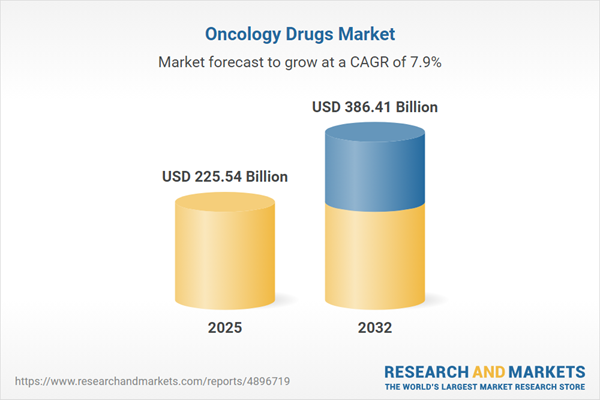Speak directly to the analyst to clarify any post sales queries you may have.
The oncology drugs market is moving into a new era, shaped by patient-centered advances, precision treatments, and digital transformation. Senior leaders face a rapidly evolving landscape defined by innovation in drug design, accelerated regulatory pathways, and dynamic supply chain considerations.
Market Snapshot: Oncology Drugs Market Growth and Trends
The Oncology Drugs Market grew from USD 210.00 billion in 2024 to USD 225.54 billion in 2025. It is expected to continue growing at a CAGR of 7.92%, reaching USD 386.41 billion by 2032. Robust expansion is driven by continual breakthroughs in molecule targeting, increased uptake of immunotherapies, and significant investments in regional capabilities. The market benefits from partnerships spanning biopharma firms, academic institutions, and technology developers, which together foster rapid translation from discovery to clinic. Shifts in tariff policy, manufacturing practices, and cross-border collaborations also influence market trajectory.
Scope & Segmentation
- Drug Classes: Chemotherapy agents (alkylating agents, antimetabolites), hormonal therapy agents, immunotherapy agents (CAR T-Cell therapy, checkpoint inhibitors including CTLA-4 inhibitors and PD-1/PD-L1 inhibitors), targeted therapy agents (monoclonal antibodies—chimeric, humanized—small molecule inhibitors, cyclin-dependent kinase inhibitors, tyrosine kinase inhibitors)
- Route of Administration: Injectable (intramuscular, intravenous, subcutaneous), oral
- Molecule Type: Biologics (monoclonal antibodies, vaccines), small molecules
- Indications: Blood cancers (acute myeloid leukemia, chronic lymphocytic leukemia, Hodgkin lymphoma, non-Hodgkin lymphoma), breast, colorectal, lung, and prostate cancers
- End Users: Hospitals, research institutes, specialty clinics
- Distribution Channels: Hospital pharmacies, online pharmacies, retail pharmacies
- Geographic Regions: Americas (North America—United States, Canada, Mexico; Latin America—Brazil, Argentina, Chile, Colombia, Peru), Europe, Middle East & Africa (United Kingdom, Germany, France, Russia, Italy, Spain, Netherlands, Sweden, Poland, Switzerland, United Arab Emirates, Saudi Arabia, Qatar, Turkey, Israel, South Africa, Nigeria, Egypt, Kenya), Asia-Pacific (China, India, Japan, Australia, South Korea, Indonesia, Thailand, Malaysia, Singapore, Taiwan)
- Companies Profiled: AbbVie Inc., Agenus Inc., Amgen Inc., Après-demain SA, Aspen Pharmacare Holdings Limited, Astellas Pharma Inc., AstraZeneca PLC, Bayer AG, BeiGene, Inc., Bristol-Myers Squibb Company, C.H. Boehringer Sohn AG & Co. KG, Cipla Limited, Eli Lilly and Company, GSK plc, Johnson & Johnson Services, Inc., Merck KGaA, Pfizer Inc., Puma Biotechnology, Inc., Roche Holding AG, Shorla Oncology, Sun Pharmaceutical Industries Ltd, Sutro Biopharma, Inc., Takeda Pharmaceutical Company Limited, Viatris Inc.
Key Takeaways for Senior Executives
- Precision medicine in oncology is replacing traditional one-size-fits-all regimens, with immunotherapy and targeted agents gaining visibility in clinical protocols and R&D pipelines.
- An increasing reliance on biomarkers and genomic profiling is streamlining patient selection, elevating both efficacy and safety across multiple cancer indications.
- Digital health tools, companion diagnostics, and real-time data sharing are becoming essential for outcome tracking and treatment optimization.
- Strategic collaboration—through consortia, licensing, and academic-industry partnerships—enables faster clinical validation and market access for novel oncology drugs.
- Segment growth differs by therapy, administration route, and region, requiring highly tailored product distribution and commercialization strategies.
- Adapting to evolving regulatory and reimbursement environments is crucial for maintaining product access and driving competitive positioning.
Tariff Impact: Navigating U.S. Policy and Global Supply Chains
Recent changes in United States tariff policies have underscored the importance of agile supply chain management for oncology drug manufacturers and developers. Increased import duties on select pharmaceutical ingredients are leading companies to explore domestic manufacturing, near-shoring, and vertical integration. The effect ripples through operational expenditure, pricing strategies, and contract negotiations. Collaborative approaches involving industry and regulatory agencies are vital for ensuring accessibility of essential therapies, despite tariff headwinds. Proactive adaptation in sourcing and policy engagement enhances resilience in this complex trade environment.
Methodology & Data Sources
This research synthesizes qualitative and quantitative methods, including expert interviews and analysis of clinical and commercial data. Sources include peer-reviewed literature, clinical trial registries, regulatory filings, and public disclosures. Data triangulation and segmentation frameworks enhance reliability and applicability for market forecasts and competitive analysis.
Why This Report Matters for B2B Leaders
- Enables targeted strategic planning, informed by nuanced segmentation and regional trends in the global oncology drugs market.
- Equips decision-makers to mitigate risks related to shifting trade policies, supply chain constraints, and evolving regulatory requirements.
- Provides a foundation for stakeholder engagement, partnership evaluation, and future investment in high-growth therapeutic areas.
Conclusion
The oncology drugs market is defined by precision therapies, complex regulatory factors, and region-specific growth opportunities. Leaders attuned to these trends can navigate uncertainty, strengthen partnerships, and optimize long-term value creation in this vital healthcare sector.
Additional Product Information:
- Purchase of this report includes 1 year online access with quarterly updates.
- This report can be updated on request. Please contact our Customer Experience team using the Ask a Question widget on our website.
Table of Contents
3. Executive Summary
4. Market Overview
7. Cumulative Impact of Artificial Intelligence 2025
Companies Mentioned
The companies profiled in this Oncology Drugs market report include:- AbbVie Inc.
- Agenus Inc.
- Amgen Inc.
- Après-demain SA
- Aspen Pharmacare Holdings Limited
- Astellas Pharma Inc.
- AstraZeneca PLC
- Bayer AG
- BeiGene, Inc.
- Bristol-Myers Squibb Company
- C.H. Boehringer Sohn AG & Co. KG
- Cipla Limited
- Eli Lilly and Company
- GSK plc
- Johnson & Johnson Services, Inc.
- Merck KGaA
- Pfizer Inc.
- Puma Biotechnology, Inc.
- Roche Holding AG
- Shorla Oncology
- Sun Pharmaceutical Industries Ltd
- Sutro Biopharma, Inc.
- Takeda Pharmaceutical Company Limited
- Viatris Inc.
Table Information
| Report Attribute | Details |
|---|---|
| No. of Pages | 198 |
| Published | November 2025 |
| Forecast Period | 2025 - 2032 |
| Estimated Market Value ( USD | $ 225.54 Billion |
| Forecasted Market Value ( USD | $ 386.41 Billion |
| Compound Annual Growth Rate | 7.9% |
| Regions Covered | Global |
| No. of Companies Mentioned | 25 |









